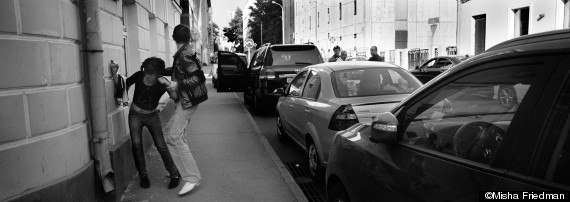
Misha Friedman’s talk about photography began with the timeline of what led him to the practice. His story begins as an immigrant from Moldova. He then studied economics and eventually started working for Doctors Without Borders. This inspired his first photo series on tuberculosis. He was interested in photographing the disease in a manner that communicated the story of the people and invoked interest. The unchanging day to day events of the patients made this difficult, and this prompted Misha Friedman to see what other observations could be meditated on through photography.
The intention behind Misha Friedman’s work is what I found most interesting. He uses a method of informed story-telling. “You only have one motherland. You have only one mother,” Misha said, when discussing why he decided to make a trip to Russia to photograph a series centered around the concept of ‘corruption’. There is no denying where you come from. His series on patriotism focused on this. He found this nagging feeling of patriotism, which inspires feelings of pride or allegiance or united ideology, prevalent in Russia in its ambiguity. The country of Russia is physically large, which is part of the reason for the many differences in belief across the regions. Another part is the segregated belief systems that have come to dominate Russia over the years. Now Russians feel not only a confused sense of patriotism but a pressure to feel a certain way about their country because of the strictness of the political structure. Friedman aims to capture the clandestine nature of political sentiment in the country through his series on patriotism. In his talk, Friedman discussed how the way of displaying photographs in a gallery is not always ideal because different galleries have different set ups and the lay out of a series is never quite the same in a different space. His solution to this was to have his photos on an interactive website. On the website is a series of portraits of Russians he interviewed, and the accompanying recording of those interviews begins to play when the portrait is clicked on. To make the series a more direct response to the question of “what is patriotism to Russians” Friedman has the portraits organized by age group and by questions asked.
Another aspect of Friedman’s work that assists in his story-telling is his use of black and white. He points to color as a complicated factor to use in photography, and that is why he uses black and white in many of his photos. It brings the viewer a finer focus on the subject matter and eliminates concerns that might interfere with the story of the image.
After the talk, there was a strong sense of intention in his work which is something I am not used to hearing from talks on arts in other mediums. As someone not too familiar with photography, I found there to be a strong focus on content for Misha’s work, as it all has ties to the political. His work is also strong in the sense that it has the communicative goal of telling a clear story, which makes his work read as informational. It is easy to perceive the message in his work, and because of that the viewer’s relative take away from the work is relatively singular and successful in bringing together a community of people to observe and process the same information.

